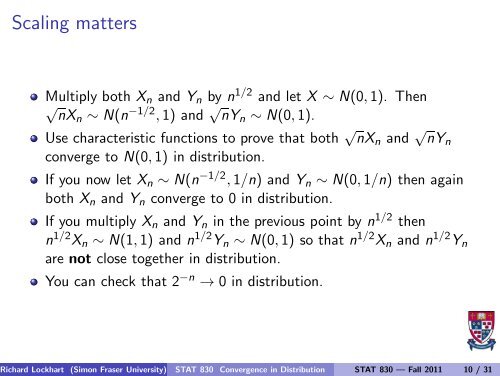STAT 830 Convergence in Distribution - People.stat.sfu.ca - Simon ...
STAT 830 Convergence in Distribution - People.stat.sfu.ca - Simon ...
STAT 830 Convergence in Distribution - People.stat.sfu.ca - Simon ...
- No tags were found...
You also want an ePaper? Increase the reach of your titles
YUMPU automatically turns print PDFs into web optimized ePapers that Google loves.
S<strong>ca</strong>l<strong>in</strong>g mattersMultiply both X n and Y n by n 1/2 and let X ∼ N(0,1). Then√ nXn ∼ N(n −1/2 ,1) and √ nY n ∼ N(0,1).Use characteristic functions to prove that both √ nX n and √ nY nconverge to N(0,1) <strong>in</strong> distribution.If you now let X n ∼ N(n −1/2 ,1/n) and Y n ∼ N(0,1/n) then aga<strong>in</strong>both X n and Y n converge to 0 <strong>in</strong> distribution.If you multiply X n and Y n <strong>in</strong> the previous po<strong>in</strong>t by n 1/2 thenn 1/2 X n ∼ N(1,1) and n 1/2 Y n ∼ N(0,1) so that n 1/2 X n and n 1/2 Y nare not close together <strong>in</strong> distribution.You <strong>ca</strong>n check that 2 −n → 0 <strong>in</strong> distribution.Richard Lockhart (<strong>Simon</strong> Fraser University) <strong>STAT</strong> <strong>830</strong> <strong>Convergence</strong> <strong>in</strong> <strong>Distribution</strong> <strong>STAT</strong> <strong>830</strong> — Fall 2011 10 / 31
















